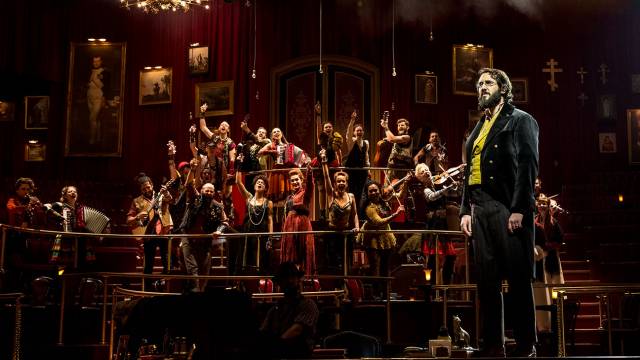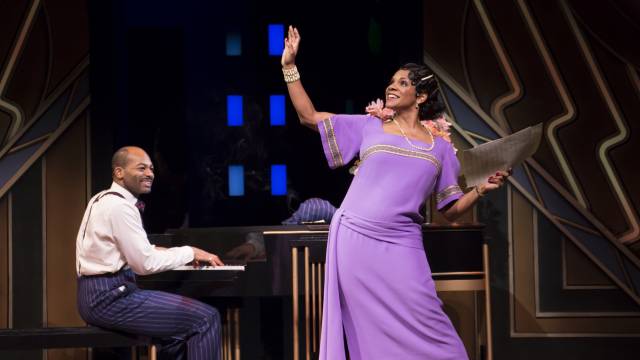
Going to the theater never felt like more of a privilege than it did in 2016. Not only because it served as the ultimate escape from the harshness of the preceding 12 months - with saw the world deal with more intolerance and collective disappointment than any of us were prepared for - but also because it was as a constant reminder that there is constant goodness and wonder at the core of humanity. In 2016 theatre became the ultimate empathy machine, in shows like Sweat and Women of a Certain Age, we were welcomed into the lives of people with different political beliefs and invited to sit and listen to them. In musicals like Tick, Tick, Boom...we were reminded about the hope of youth and how death is the only thing we’re promised when we’re born, in comedy shows like Josie Long: Something Better, the stage served as a place for healing, and it’s testament to the quality of the year, that none of these shows even made it to my final list.
Out of the 253 shows I saw this year, many uplifted me, others crushed me, and going back to think about the shows that have remained in my mind and heart for months, it makes sense that they are the ones that spoke about our capacity for love, soulful technological development, endless compassion and need for community. While ten is an entirely arbitrary number chosen out of need for deadlines, rather than quality (otherwise we would be here through 2018), may the following serve as reminders that on a daily basis there is so much more to be grateful for, rather than sorry, in the world.
Disclaimer: West Side Story is my favorite musical of all time. That doesn’t mean a production of it will instantly skyrocket to the top of my favorites, but instead that I will approach it with utmost fear - will they make it justice? The unforgettable production included here, was part of Carnegie Hall’s impressive The Somewhere Project, a unique outreach program that used the Leonard Bernstein/Stephen Sondheim musical to introduce New York high school students to musical theatre, and also to allow them to explore the city in the most original way: by allowing it to serve as their source of inspiration for creation. The project culminated with a site-specific production of the musical set at The Knockdown Center in Ridgewood, a former door warehouse, that during the first weekend in March became a factory of dreams.
Not only those of the audience who sat enraptured by the music and lyrics (original Anita, Chita Rivera attended opening night!), but those of performers who were making their debut (newcomer Morgan Hernandez shone as Maria) and those who have been in the business for decades and dreamt of their time to do this musical (Bianca Marroquín’s Anita was the single best performance I saw onstage in 2016). Filled with moments that seemed lifted out of pure fantasy, director Amanda Dehnert, was able to make the musical seem timeless and fresh. When the time arrived for the cast to burst into “Somewhere”, they were joined onstage by dozens of singers, students from all over the city who sang in unison while holding candles. As they sang “there’s a place for us, somewhere a place for us” and I found my heart being lifted to heaven, I couldn’t have imagined that this would be the moment I would use as refuge from tragedy during the rest of the year. (Read my interview with Bianca Marroquín)
When your job is to see theatre, there comes a time when undoubtedly you feel like you’ve seen it all. Leave it to performance artist Andrew Schneider to turn your world upside down as he challenges your notion of reality and fiction using sounds and images. YOUARENOWHERE was the one show this year, where I wanted to pause the action and turn to see how other audience members were reacting. Filled with “did you see that?” moments that made it endlessly entertaining, the show was also a melancholic meditation on our lack of awareness and need for connection. (Read my interview with Andrew Schneider)
That thing about empathy and the theatre means that sometimes we have to see shows about people whose moral center couldn’t be farther away from ours. Such is the case with Patrick Bateman (Benjamin Walker) the anti-hero at the center of Duncan Sheik’s musical adaptation of Bret Easton Ellis’ iconic novel, who has, figuratively, exchanged his soul for wealth, women, clothes, and is now looking to fill his emptiness by murdering people he deems inferior. Sheik’s witty use of synth pop and electronica to make Bateman even more unapproachable, paid off intellectually (for what was the show if not an eerie preview of #MAGA mentality?) but flopped commercially (why would we have wanted to see frail white masculinity under the spotlight?) and it made sense. It’s rare for art to allow us to stare deep into the abyss, because the idea of finding ourselves within it is sometimes too unbearable to conceive. (Read my review)
 4. Natasha, Pierre and the Great Comet of 1812
4. Natasha, Pierre and the Great Comet of 1812
There simply has never been anything like this show on Broadway. If the novelty of attending a fully immersive commercial show on the Great White Way wasn’t enough to attract audiences, Dave Malloy’s grand musical is also a celebration of life through art. Thanks to Rachel Chavkin’s direction this is the kind of musical where all five senses are engaged - even if momentarily - and given several cast members made their way from the Off-Broadway productions, it’s a great time for mainstream audiences to be introduced to the magic of Amber Gray.
Anna Ziegler is the kind of playwright whose works still defy categorization. Summing up the plot of Boy is rather easy, but somehow it feels like a disservice to the beauty in Ziegler’s words, and her profound love for her characters. In a year like 2016 where toxic masculinity prevailed over our better sense, her play about a young woman who finds herself discovering she is not who she thought she was from a biological perspective, became a testament to the importance of compassion, not only for those around us but for ourselves. In her gorgeous play, Ziegler was able to continue her exploration of the human soul going beyond the limitations of gender and societal codes that has made her one of the most compelling voices in American dramatic writing. (Read my review and my interview with Anna Ziegler)
 6. Shuffle Along, or, the Making of the Musical Sensation of 1921 and All That Followed
6. Shuffle Along, or, the Making of the Musical Sensation of 1921 and All That Followed
Watching Ava DuVernay’s 13th a few months after the unexpected closing of George C. Wolfe’s musical, I found myself thinking of them as spiritual companions. Both were incredibly timely artworks that dealt with little known, or little discussed, pieces of information about African American history. Both were also far from perfect in terms of structure and storytelling, but at their center they both carried a fire that made traditional aesthetic criticisms feel preposterous and invalid: here were two works by notorious black artists that simply needed to exist at this moment in time, form be damned! Sitting through the Broadway show about the making of the first all-black musical, I could imagine Mr. Wolfe sitting at his desk furiously writing the book as if possessed by the pulse of history itself.
Entering The Connelly Theater for Daniel Alexander Jones’ Duat, felt like walking into a portal to a different dimension. One where all aspects of our history coexisted, and where love for one another was the most important lesson taught in school. To say that sitting through the first half of the show felt like spying into Jones’ subconscious would be an understatement, for rarely has it felt like an artist was granting us access into his dreams the way we saw in Duat. By the time Jomama Jones made her appearance in the rapturous second half, the show had seduced us to the point where we left the show wishing Jones’ dreams and memories became our own. (Read my interview with Daniel Alexander Jones)
Jessie Mueller gave one of the most stirring performances of the year as Jenna, the title server who dreams of escaping her humdrum life and finding true purpose. The problem is the world she lives in has decided to make her believe she’s simply not worth it. With evocative songs by Sara Bareilles, a book by Jessie Nelson that vastly improved on the source material, and precise direction by Diane Paulus, Waitress became one of the most unexpected surprises on Broadway, a musical with heart, guts and staying power, a feminist show with an urgent message that found its rightful place among wizards, singing cats and rapping founding fathers. (Read my review)
October was a blessed month for New Yorkers who had the opportunity to attend four different shows by iconoclastic choreographer Jérôme Bel, as part of FIAF’s Crossing the Line Festival. Among them were a film, his shocking breakthrough, a new show commissioned by MoMA, and The Show Must Go On, perhaps his most widely known work which features mostly non-professional performers in a series of vignettes featuring songs like “Macarena” and “My Heart Will Go On”. It’s hard to think of ways to describe Bel’s works that he would agree with, but the closest I’ve found is to deem them democratic. They’re reminders that in our own way, we can all be creators and artists. That they accomplish this without recurring to romanticism or platitudes, or without themselves into total anarchy is why the other word that keeps coming to me when I think of Bel’s work is “miraculous”.
Phylicia Rashad took the Book of Job for a spin in Tarell Alvin McCraney’s absolutely majestic Head of Passes, which saw the iconic actress play Shelah, an aging matriarch who over the course of a night sees her life altered as tragedy strikes. Her character, named after the Hebrew word for “petition”, goes from being a traditional heroine, into becoming a Shakespearean figure that commands hurricanes with one word. The play which opened during the spring, seemed eerily prescient of how so many of us would be left looking at the heavens asking for answers as the year came to its end. But just as it does Shelah, the play reminds us that if there is a trace of the divine within us, it’s our duty to carve our own fate. (Read my review)